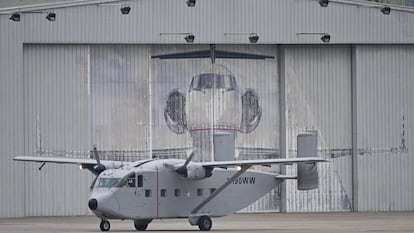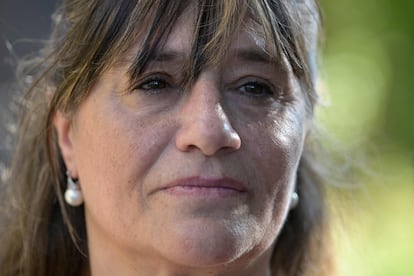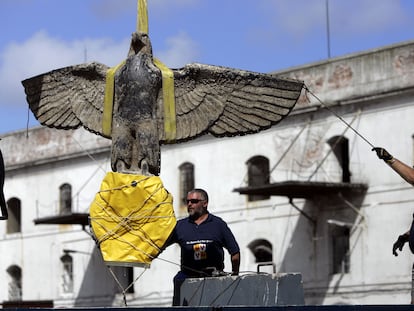Return of Skyvan used for Argentina death flights leads to mixed emotions for victims’ families
In 1977, three founders of the Mothers of the Plaza de Mayo human rights organization, two French nuns and several others were thrown into the sea from the aircraft, one of many such flights conducted under the dictatorship


On the night of December 14, 1977, three members of the Mothers of the Plaza de Mayo human rights organization — Azucena Villaflor, Esther Ballestrino de Careaga and María Eugenia Ponce de Bianco — were thrown alive into the sea from a Skyvan PA-51 military plane. The brutal Argentinean dictatorship, which first disappeared their children then kidnapped those mothers who were searching for them, tortured them, and tried to dispose of their bodies on a death flight. Along with Villaflor, Ballestrino and Ponce de Bianco, French nuns Alice Domon and Leonie Duquet and seven other victims were also murdered that night. The Skyvan, located in the United States thanks to a journalistic investigation, has now been repatriated to Argentina after almost three decades out of the country. It will be transferred to the former Higher School of Mechanics of the Navy (ESMA), which hosted the largest clandestine detention center of the military regime, as a symbol of the horrors of the dictatorship (1976-1983).
“We have mixed emotions,” says Cecilia de Vincenti, Villaflor’s daughter, standing in front of the Skyvan in the military sector of Jorge Newbery Airport in Buenos Aires. “On the one hand, something that we have wanted to happen for many years has come true, but on the other hand it triggers feelings of sadness, pain and despair, because if we could change history we would, but unfortunately we can’t.”
De Vincenti poses for the cameras with Mabel Careaga, Esther Ballestrino’s daughter. From time to time, they embrace. Both turn their backs on the sinister plane, the last place their mothers were alive, after having spent almost a week in custody at ESMA. “When we found out what had happened to them, we couldn’t believe it; we couldn’t believe there was so much evil,” Careaga says.

The 12 victims of the founding nucleus of the Mothers of the Plaza de Mayo collected funds at the doors of the Santa Cruz Church to pay for an advertisement in the newspaper La Nación, which listed the names of 804 missing persons. They were targeted by Navy Captain Alfredo Astiz, who had pretended to be the brother of one of the disappeared and had gained their trust. Astiz singled out those that were to be kidnapped and passed the information to the military authorities.
The aircraft was located by investigative journalist Miriam Lewin, together with Italian photographer Giancarlo Ceraudo, 15 ago in Fort Lauderdale, Florida. At the time, it was part of the fleet of a U.S. postal company. Ceraudo inspected its interior and photographed the fateful plaque: “Tailgate operation. Not to be opened during flight except on captain’s orders.” The mechanism to activate it was on the co-pilot’s side, one of the pieces of evidence presented to the Argentinean judiciary, which in 2017 sentenced the two pilots on that flight, Mario Daniel Arru and Alejandro Domingo D’Agostino, to life imprisonment.
Lewin, who survived the ESMA, was with Ceraudo in Fort Lauderdale but stayed as far away from the Skyvan as she could. When she saw the plane land in Buenos Aires, she wept, as did many of those who contributed to its recovery. She believes its significance will be key for new educating new generations, who did not experience the military regime firsthand, and as physical proof against denialist discourse. “In this era of the rise of denialism, it is very important to have a material manifesto of the evil and the refinement of the methods used to dispose of the bodies of the disappeared. Not only did they want to disappear people, but they wanted to guarantee, without any margin for error or doubt, that their bodies could not be found,” says Lewin.

The sea, though, did not swallow up the bodies of the founders of the Mothers of the Plaza de Mayo, but washed them up on the coast of Santa Teresita, almost 350 kilometers (217 miles) south of Buenos Aires. A forensic report indicated that they had fractures compatible with a fall from height, but no investigation was opened. They were buried as “NN” (unidentified corpses) in a local cemetery and remained there until 2005, when the Argentine Forensic Anthropology Team exhumed the remains and confirmed their identities. Their relatives, who were able to properly mourn after the operation, pushed for the purchase of the Skyvan, which was completed by the Ministry of Economy.
“This plane must be at ESMA, as part of history, so that something like this will never happen again,” said De Vicenti. Villaflor and Ballestrini’s daughters participated in the official act to mark the recovery of the Skyvan on Monday, presided by Argentinean Vice President Cristina Fernández de Kirchner. “It is incredible that there are those who deny what happened,” said Kirchner during her speech, in which she said she was in favor of promoting a law against denialism similar to the one in force in Germany regarding Nazi crimes.
According to Argentine Naval Prefecture flight logs, the death flights took place at night and lasted between two and a half and three hours. The Skyvans made about 200 flights between 1976 and 1978. That of December 14, 1977, took off from Jorge Newbery Airport in Buenos Aires, located on the River Plate. The same plane landed last Saturday at the same place, closing the circle of one of the darkest chapters of Argentinean history.
Sign up for our weekly newsletter to get more English-language news coverage from EL PAÍS USA Edition
Tu suscripción se está usando en otro dispositivo
¿Quieres añadir otro usuario a tu suscripción?
Si continúas leyendo en este dispositivo, no se podrá leer en el otro.
FlechaTu suscripción se está usando en otro dispositivo y solo puedes acceder a EL PAÍS desde un dispositivo a la vez.
Si quieres compartir tu cuenta, cambia tu suscripción a la modalidad Premium, así podrás añadir otro usuario. Cada uno accederá con su propia cuenta de email, lo que os permitirá personalizar vuestra experiencia en EL PAÍS.
¿Tienes una suscripción de empresa? Accede aquí para contratar más cuentas.
En el caso de no saber quién está usando tu cuenta, te recomendamos cambiar tu contraseña aquí.
Si decides continuar compartiendo tu cuenta, este mensaje se mostrará en tu dispositivo y en el de la otra persona que está usando tu cuenta de forma indefinida, afectando a tu experiencia de lectura. Puedes consultar aquí los términos y condiciones de la suscripción digital.
More information
Archived In
Últimas noticias
Most viewed
- Sinaloa Cartel war is taking its toll on Los Chapitos
- Oona Chaplin: ‘I told James Cameron that I was living in a treehouse and starting a permaculture project with a friend’
- Reinhard Genzel, Nobel laureate in physics: ‘One-minute videos will never give you the truth’
- Why the price of coffee has skyrocketed: from Brazilian plantations to specialty coffee houses
- Silver prices are going crazy: This is what’s fueling the rally










































